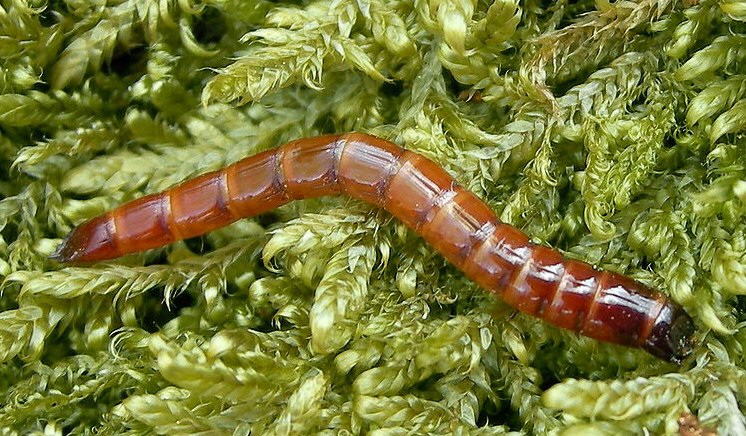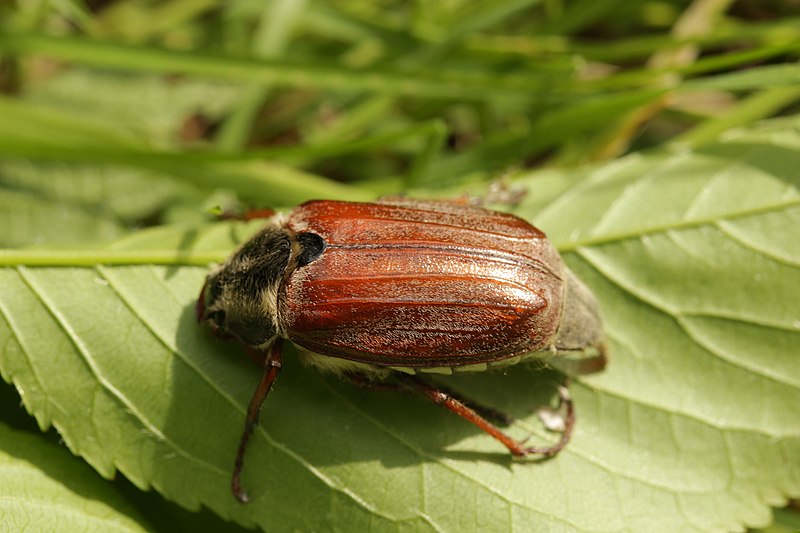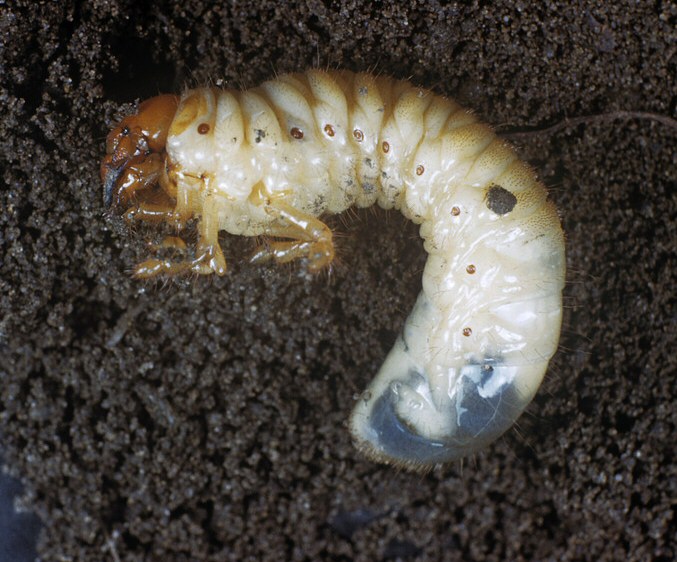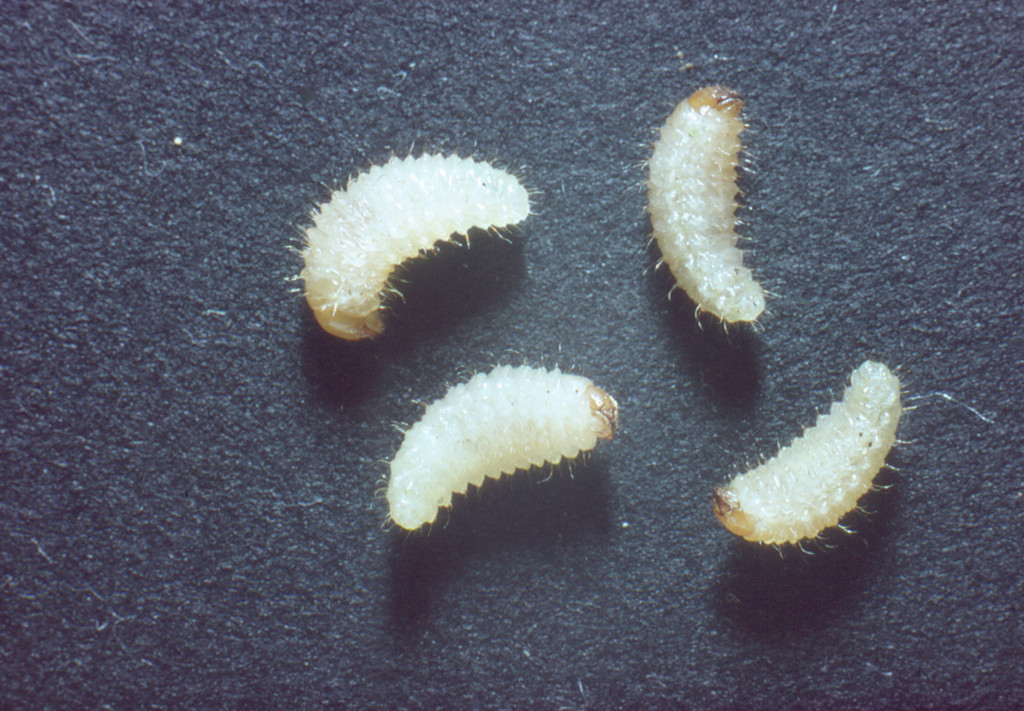- Home
- Garden Wildlife
- Insects
- Beetles
- Root-eating beetles
Life cycle
Click beetles, chafer beetles and vine weevil lay their eggs in the soil. Vine weevils also lay eggs in plant pots, hanging baskets and window boxes. The Vine weevil (like aphids) is an insect that occurs as females only in northern Europe and they reproduce asexually. Sexual races occur in Italy. The larvae of root-eating beetles feed until they are ready to pupate. Some wireworms will take several years before they become fully fed. Vine weevil and most chafer grubs complete their development in a single year but cockchafer grubs can take three years. Pupation occurs in the soil and it usually as pupae that these insects overwinter.
Role of root-eating beetles in gardens
Cockchafer grubs can damage the roots of annual and bedding plants in flower beds, or they may damage potato tubers and root vegetables. The larvae of the garden chafer and Welsh chafer feed on the roots of grasses. Heavy infestations can sever most of the roots, allowing foxes, badgers and birds of the crow family to rip up the turf in search of the grubs. This is a form of biological control but a lawn can look like a ploughed field by the time the predators have finished. This damage generally occurs in the autumn when chafer grubs are becoming fully grown.
Root-eating wireworms’ natural habitat is under grassland, but they have little impact on the appearance of lawns. Problems can occur when lawns or other grassy areas are dug up and converted into vegetable plots or flower beds. Wireworms then turn their attention to whatever is sown or planted in the cultivated ground. Seedlings may be killed and root vegetables and potato tubers are tunnelled by the larvae.
Vine weevil grubs are among the most damaging garden pests. They are one of the few insects capable of killing plants by devouring all or most of the root system. A wide range of plants is vulnerable, especially those being grown in pots or other containers. Plant losses generally occur during early autumn to spring as the larvae become fully grown.
Other sources of information
Websites
Elateridae of the British Isles website
Mark Telfer's web page on click beetles
Mark Telfer's web page on weevils
Books
Jessop, L. (1986) Handbooks for the Identification of British Insects Vol 5 part 11. Dung beetles and chafers
(Coleoptera:Scarabaeoidea). available as a free download
Morris, M. G. (1997) Handbooks for the Identification of British Insects Vol 5 part 17a. Broad-nosed weevils
Coleoptera: Curculionidae (Entiminae). Royal Entomological Society
By Andrew Halstead reviewed by Andrew Salisbury edited by Steve Head
Root-eating beetles
The most important beetle families with species that feed on live plant roots are the Scarabaeidae, subfamily Elateridae or click beetles and Melolonthinae or chafers, and the Curculionidae or weevils (also discussed under leaf-eating beetles). In all cases, it is the larval stage, rather than the adult beetles, that feed on roots. Some are important garden pests.
Species in Britain and Ireland
Seventy three species of Elateridae beetles have been recorded in Britain and Ireland. The adult beetles are commonly known as click beetles and the larvae as wireworms. Some click beetle larvae develop in rotten wood or in the soil in habitats other than gardens. Some are garden pests, particularly some Agriotes and Athous species. Apart from the pests, it seems little attention has been given to these species in gardens.
The larvae of chafer beetles, of which there are 16 species in Britain and Ireland, are known as chafer grubs. As with wireworms, some chafer grubs develop in rotten wood, but there are some garden pests. These include the garden chafer, Phyllopertha horticola, cockchafer or Maybug, Melolontha melolontha and the Welsh Chafer, Hoplia philanthus. The last mentioned occurs in England and Wales, particularly in sandy soil districts. Chafer grubs are sometimes found at the bottom of compost heaps. These are larvae of the rose chafer, Cetonia aurata, which is not a pest species as the larvae feed on rotting plant material.
There are over 430 weevils, with many developing as larvae in the soil, but only a few cause significant damage to cultivated plants. The principal culprit is the vine weevil, Otiorhynchus sulcatus.
Biology
Click beetle larvae, known as wireworms, are slender elongate grubs up to 25mm long. They are yellowish brown and have three pairs of short legs at the head end, with a fleshy protuberance on the underside at the rear end. Adult click beetles are slender in form with a marked "waist" between thorax and abdomen. They have a peg-like structure on the underside of their thorax that fits into a cavity on the abdomen. If an adult click beetle finds itself threatened or upside down, it flexes its body, storing energy, and releases the peg with an audible ‘click’ sound, and flexing the abdomen. This flips the beetle into the air, giving it the opportunity to land right way up - or to escape predators. The mechanism is described here. Like the cuckoo, it is one of the few animals that can ‘speak’ its name.
![Photo: Dick Belgers at waarneming.nl, a source of nature observations in the Netherlands. [CC BY 3.0 (https://creativecommons.org/licenses/by/3.0)], via Wikimedia Commons](images/Agriotes_acuminatus1.jpg)
Above left: Brown click beetle Agriotes acuminatus 6-8mm
Above right: Athous haemorrhoidalis adult 10-15mm long, showing the marked "waist" essential for the click mechanism.
Left: Agriotes lineatus larva or "wireworm" up to 25mm length
![Photo: André Karwath aka Aka [CC BY-SA 2.5 (https://creativecommons.org/licenses/by-sa/2.5)], from Wikimedia Commons](images/800px-Athous_haemorrhoidalis_-_side_(aka).jpg)

Chafer grubs are creamy white, with brown heads and three pairs of legs. They typically hold their bodies curved like a letter C. When fully grown, chafer grubs are 18-35mm long, with cockchafer larvae being the largest of those likely to be found in gardens. Adult chafer beetles feed on the foliage of a wide range of plants but do not cause significant damage.
Left: Vine weevil larvae are of similar colour to chafer grubs but their bodies are only slightly curved and they have no legs. They are up to 11mm long. Some weevils have adults that can damage the foliage of garden plants. (see our page on leaf beetles) Vine weevils are incapable of flying but have no difficulty in getting around by crawling.
![Photo: David Short from Windsor, UK [CC BY 2.0 (https://creativecommons.org/licenses/by/2.0)], via Wikimedia Commons](images/Cockchafer_(BG)_(27014330155).jpg)

Top left: Cockchafer beetle Melolantha melolantha 25-30mm
Top right: Cockhafer with wings exposed - note the hard front wings which form protective plates called elytra - a key beetle feature. This also shows the fan-form of the male's antennae
Left: Cockchafer larva or "rookworm" up to 40mm long


Root-eating beetles
The most important beetle families with species that feed on live plant roots are the Scarabaeidae, subfamily Elateridae or click beetles and Melolonthinae or chafers, and the Curculionidae or weevils (also discussed under leaf-eating beetles). In all cases, it is the larval stage, rather than the adult beetles, that feed on roots. Some are important garden pests.
Species in Britain and Ireland
Seventy three species of Elateridae beetles have been recorded in Britain and Ireland. The adult beetles are commonly known as click beetles and the larvae as wireworms. Some click beetle larvae develop in rotten wood or in the soil in habitats other than gardens. Some are garden pests, particularly some Agriotes and Athous species. Apart from the pests, it seems little attention has been given to these species in gardens.
The larvae of chafer beetles, of which there are 16 species in Britain and Ireland, are known as chafer grubs. As with wireworms, some chafer grubs develop in rotten wood, but there are some garden pests. These include the garden chafer, Phyllopertha horticola, cockchafer or Maybug, Melolontha melolontha and the Welsh Chafer, Hoplia philanthus. The last mentioned occurs in England and Wales, particularly in sandy soil districts. Chafer grubs are sometimes found at the bottom of compost heaps. These are larvae of the rose chafer, Cetonia aurata, which is not a pest species as the larvae feed on rotting plant material.
There are over 430 weevils, with many developing as larvae in the soil, but only a few cause significant damage to cultivated plants. The principal culprit is the vine weevil, Otiorhynchus sulcatus.
Biology
Click beetle larvae, known as wireworms, are slender elongate grubs up to 25mm long. They are yellowish brown and have three pairs of short legs at the head end, with a fleshy protuberance on the underside at the rear end. Adult click beetles are slender in form with a marked "waist" between thorax and abdomen. They have a peg-like structure on the underside of their thorax that fits into a cavity on the abdomen. If an adult click beetle finds itself threatened or upside down, it flexes its body, storing energy, and releases the peg with an audible ‘click’ sound, and flexing the abdomen. This flips the beetle into the air, giving it the opportunity to land right way up - or to escape predators. The mechanism is described here. Like the cuckoo, it is one of the few animals that can ‘speak’ its name.
![Photo: Dick Belgers at waarneming.nl, a source of nature observations in the Netherlands. [CC BY 3.0 (https://creativecommons.org/licenses/by/3.0)], via Wikimedia Commons](images/Agriotes_acuminatus1.jpg)
![Photo: André Karwath aka Aka [CC BY-SA 2.5 (https://creativecommons.org/licenses/by-sa/2.5)], from Wikimedia Commons](images/800px-Athous_haemorrhoidalis_-_side_(aka).jpg)

Above left: Brown click beetle Agriotes acuminatus 6-8mm
Above right: Athous haemorrhoidalis adult 10-15mm long, showing the marked "waist" essential for the click mechanism.
Left: Agriotes lineatus larva or "wireworm" up to 25mm length

![Photo: David Short from Windsor, UK [CC BY 2.0 (https://creativecommons.org/licenses/by/2.0)], via Wikimedia Commons](images/Cockchafer_(BG)_(27014330155).jpg)
Chafer grubs are creamy white, with brown heads and three pairs of legs. They typically hold their bodies curved like a letter C. When fully grown, chafer grubs are 18-35mm long, with cockchafer larvae being the largest of those likely to be found in gardens. Adult chafer beetles feed on the foliage of a wide range of plants but do not cause significant damage.

Top left: Cockchafer beetle Melolantha melolantha 25-30mm
Top right: Cockhafer with wings exposed - note the hard front wings which form protective plates called elytra - a key beetle feature. This also shows the fan-form of the male's antennae
Left: Cockchafer larva or "rookworm" up to 40mm long

Life cycle
Click beetles, chafer beetles and vine weevil lay their eggs in the soil. Vine weevils also lay eggs in plant pots, hanging baskets and window boxes. The Vine weevil (like aphids) is an insect that occurs as females only in northern Europe and they reproduce asexually. Sexual races occur in Italy. The larvae of root-eating beetles feed until they are ready to pupate. Some wireworms will take several years before they become fully fed. Vine weevil and most chafer grubs complete their development in a single year but cockchafer grubs can take three years. Pupation occurs in the soil and it usually as pupae that these insects overwinter.
Role of root-eating beetles in gardens
Cockchafer grubs can damage the roots of annual and bedding plants in flower beds, or they may damage potato tubers and root vegetables. The larvae of the garden chafer and Welsh chafer feed on the roots of grasses. Heavy infestations can sever most of the roots, allowing foxes, badgers and birds of the crow family to rip up the turf in search of the grubs. This is a form of biological control but a lawn can look like a ploughed field by the time the predators have finished. This damage generally occurs in the autumn when chafer grubs are becoming fully grown.
Root-eating wireworms’ natural habitat is under grassland, but they have little impact on the appearance of lawns. Problems can occur when lawns or other grassy areas are dug up and converted into vegetable plots or flower beds. Wireworms then turn their attention to whatever is sown or planted in the cultivated ground. Seedlings may be killed and root vegetables and potato tubers are tunnelled by the larvae.
Vine weevil grubs are among the most damaging garden pests. They are one of the few insects capable of killing plants by devouring all or most of the root system. A wide range of plants is vulnerable, especially those being grown in pots or other containers. Plant losses generally occur during early autumn to spring as the larvae become fully grown.
Other sources of information
Websites
Elateridae of the British Isles website
Books
Jessop, L. (1986) Handbooks for the Identification of British Insects Vol 5 part 11.
Dung beetles and chafers (Coleoptera:Scarabaeoidea).
available as a free download
Morris, M. G. (1997) Handbooks for the Identification of British Insects Vol 5 part
17a. Broad-nosed weevils Coleoptera: Curculionidae (Entiminae).
Royal Entomological Society
By Andrew Halstead reviewed by Andrew Salisbury edited by Steve Head
Left: Vine weevil larvae are of similar colour to chafer grubs but their bodies are only slightly curved and they have no legs. They are up to 11mm long. Some weevils have adults that can damage the foliage of garden plants. (see our page on leaf beetles) Vine weevils are incapable of flying but have no difficulty in getting around by crawling.












